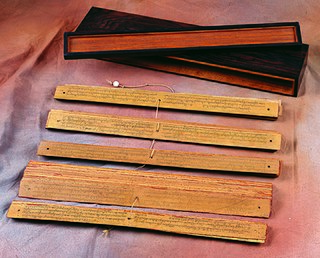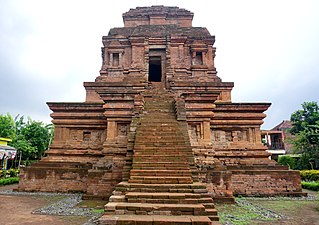
The Majapahit Empire was a Javanese Hindu-Buddhist thalassocratic empire in Southeast Asia, based on the island of Java, that existed from 1293 to circa 1527. Majapahit reached its peak of glory during the era of Hayam Wuruk, whose reign from 1350 to 1389 was marked by conquest which extended through Southeast Asia. His achievement is also credited to his prime minister, Gajah Mada. According to the Nagarakretagama (Desawarñana) written in 1365, Majapahit was an empire of 98 tributaries, stretching from Sumatra to New Guinea; consisting of present-day Indonesia, Singapore, Malaysia, Brunei, southern Thailand, East Timor, Sulu Archipelago and other parts of the Philippines, although the true nature of Majapahit sphere of influence is still the subject of studies among historians.

Borobudur, or Barabudur is a 9th-century Mahayana Buddhist temple in Magelang Regency, not far from the town of Muntilan, in Central Java, Indonesia. It is the world's largest Buddhist temple. The temple consists of nine stacked platforms, six square and three circular, topped by a central dome. It is decorated with 2,672 relief panels and 504 Buddha statues. The central dome is surrounded by 72 Buddha statues, each seated inside a perforated stupa.

'Prambanan' or 'Rara Jonggrang' is a 9th-century Hindu temple compound in Special Region of Yogyakarta, Indonesia, dedicated to the Trimūrti, the expression of God as the Creator (Brahma), the Preserver (Vishnu) and the Transformer (Shiva). The temple compound is located approximately 17 kilometres (11 mi) northeast of the city of Yogyakarta on the boundary between Central Java and Yogyakarta provinces.

Singhasari was an Indianized Javanese Hindu–Buddhist kingdom located in east Java between 1222 and 1292. The kingdom succeeded the Kingdom of Kediri as the dominant kingdom in eastern Java. The kingdom's name is cognate to Singosari district of Malang Regency, located several kilometres north of Malang city.

The Nagarakretagama or Nagarakrtagama, also known as Desawarñana or Deshavarñana, is an Old Javanese eulogy to Hayam Wuruk, a Javanese king of the Majapahit Empire. It was written on lontar as a kakawin by Mpu Prapanca in 1365. The Nagarakretagama contains detailed descriptions of the Majapahit Empire during its greatest extent. The poem affirms the importance of Hindu–Buddhism in the Majapahit empire by describing temples and palaces and several ceremonial observances.

A candi is a Hindu or Buddhist temple in Indonesia, mostly built during the Zaman Hindu-Buddha or "Hindu-Buddhist period", between the 4th and 15th centuries.

Sukuh is a 15th-century Javanese-Hindu temple (candi) that is located on the western slope of Mount Lawu on the border between Central and East Java provinces.
The history of arrival and spread of Islam in Indonesia is unclear. One theory states it arrived directly from Arabia before the 9th century, while another credits Sufi merchants and preachers for bringing Islam to Indonesian islands in the 12th or 13th century either from Gujarat in India or directly from the Middle East. Before the arrival of Islam, the predominant religions in Indonesia were Buddhism and Hinduism.

Trowulan is an archaeological site in Trowulan Subdistrict, Mojokerto Regency, in the Indonesian province of East Java. It includes approximately 100 square kilometres and has been theorized to be the site of the eponymous capital city of the Majapahit Empire, which is described by Mpu Prapanca in the 14th-century poem Nagarakretagama and in a 15th-century Chinese source. When it was the capital of the Majapahit Empire, the city was known as Wilwatikta, which is a name also synonymous with the empire's name. It was razed during the invasion of Girindrawardhana to defeat Kertabhumi in 1478. After this event Majapahit's capital was moved to Daha (Kediri). The Trowulan Museum includes a collection of artifacts.
Indonesian Esoteric Buddhism or Esoteric Buddhism in Maritime Southeast Asia refers to the traditions of Esoteric Buddhism found in Maritime Southeast Asia which emerged in the 7th century along the maritime trade routes and port cities of the Indonesian islands of Java and Sumatra as well as in Malaysia. These esoteric forms were spread by pilgrims and Tantric masters who received royal patronage from royal dynasties like the Sailendras and the Srivijaya. This tradition was also linked by the maritime trade routes with Indian Vajrayana, Tantric Buddhism in Sinhala, Cham and Khmer lands and in China and Japan, to the extent that it is hard to separate them completely and it is better to speak of a complex of "Esoteric Buddhism of Mediaeval Maritime Asia." In many of the key South Asian port cities that saw the growth of Esoteric Buddhism, the tradition coexisted alongside Shaivism.

Penataran or Panataran is one of the largest Hindu temple ruins complex in East Java, Indonesia. It is located roughly 12 km northeast of Blitar, with the closest airport being farther away at Malang. Believed to have been constructed between the 12th century to the 15th century, the temple played a significant role in the Majapahit Kingdom, especially under King Hayam Wuruk. He considered his favorite sanctuary. Penataran dates from the Kediri era.

The Menara Kudus Mosque or Al-Aqsha Mosque is located in Kudus in the Indonesian province of Central Java. Dating from 1549, it is one of the oldest mosques in Indonesia, built at the time of Islam's spread through Java. The mosque preserves the tomb of Sunan Kudus, one of the nine Islamic saints of Java, and it is a popular pilgrimage point.

Jabung is a 14th-century Buddhist temple dated from Majapahit era, located in the Jabung Sisir village (desa), Paiton area, Probolinggo district, East Java, Indonesia. The temple is made from red brick measuring 16.20 metres. The temple was mentioned in Nagarakretagama as Bajrajinaparamitapura, being visited by king Hayam Wuruk during his royal tour across East Java in 1359 CE. The temple is mentioned in Pararaton as Sajabung, a mortuary temple of Bhre Gundal, a member of Majapahit royalties.
Sri Tanjung also known as the tale of Banyuwangi is Javanese folklore which tells a story about a faithful wife that was wrongfully accused. The story has been popular since the era of Majapahit kingdom. The story is usually performed as kidung a poem sung or chanted in Javanese tembang. The Kidung Sri Tanjung are performed in the traditional Javanese ruwatan ceremony. The name Sri Tanjung was connected to the Tanjung flower, a flower with a sweet fragrance.
Arjunawiwāha was the first kakawin appeared in the East Javan period of the Javanese classical Hindu-Buddhist era in the 11th-century. Arjunawiwaha was composed by Mpu Kanwa during the reign of King Airlangga, king of the Kahuripan Kingdom, circa 1019 to 1042 CE. Arjunawiwaha is estimated to be finished in 1030.

Javanisation is the process in which Javanese culture dominates, assimilates, or influences other cultures in general. The term "Javanise" means "to make or to become Javanese in form, idiom, style, or character." This domination could take place in various aspects; such as cultural, language, politics and social.

Dieng temples is the group of 7th and/or eighth century Hindu candi or temple compounds located in Dieng Plateau, near Wonosobo, Central Java, Indonesia. These edifices originate from the Kalingga Kingdom. The plateau is home of eight small Hindu temples that are among the oldest surviving religious structures ever built in Java, and the earliest Hindu temples in Indonesia. The temples show many features of Indian Hindu temple architecture.
Paregreg war was the Majapahit civil war that took place in 1404-1406. The conflict was fought as a war of independence between the Western court led by Wikramawardhana against the breakaway Eastern court led by Bhre Wirabhumi. This war of rivalry and secession had caused the calamity, crisis, court's preoccupation, the drain of financial resources, and exhaustion, that is thought to be one of the causes of Majapahit decline in the following years.

Candi bentar, or split gateway, is a classical Javanese and Balinese gateway entrance commonly found at the entrance of religious compounds, kraton palaces, or cemeteries. It is basically a candi-like structure split perfectly in two to create a passage in the center for people to walk through. The passage is usually elevated with a flight of stairs to reach it. A candi bentar is commonly found in Java, Bali, and Lombok.

Gunung Gangsir is an 11th-century Hindu candi (temple) located approximately 5 kilometers west from the town of Bangil. This red brick structure is located in Gunung Gangsir village, Beji subdistrict, Pasuruan Regency, East Java Indonesia.

















